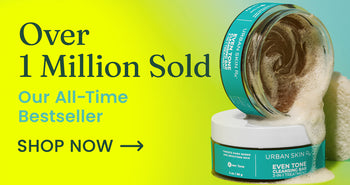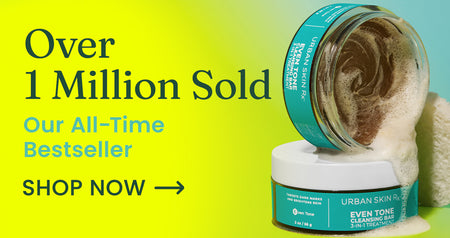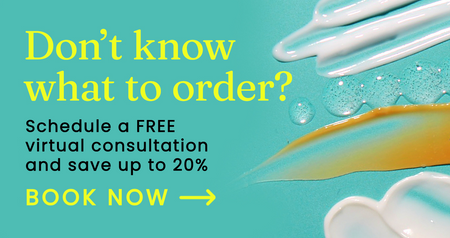Can You Mix Niacinamide and Retinol?

If you’ve spent time around anti-aging skincare, you may know that some popular ingredients just don’t get along. For instance, Retinol and Lactic Acid can often cause discomfort if used together.
But what about Retinol and Niacinamide? These two hero ingredients are well-known for their skin-smoothing powers, but can you use them together?
We say yes, and here’s why.
What Is Niacinamide?
You may see this ingredient in products designed for smooth, bright and even clear skin. But can Niacinamide really do all of that?
The short answer is yes. Niacinamide is an incredibly versatile skincare ingredient included in many multi-purpose formulas.
You may also know this ingredient by its other name, Nicotinamide, which can be confusing, but just know that Nicotinamide and Niacinamide are exactly the same.
Niacinamide is a form of Vitamin B3, which helps keep your skin soft and hydrated. Vitamin B is an important part of your body’s digestive processes, but it’s also vital for skincare.
Even though it’s so important, your body does not make Vitamin B3 naturally — you need to constantly replenish your body’s supply through a healthy diet and support your skin with topical solutions like Niacinamide.
What Does Niacinamide Do?
Niacinamide is a wearer of many hats. Your skin is your body’s first line of defense against outside contaminants like germs and bacteria, and Niacinamide can help keep your skin in tip-top shape.
It does this by supporting your skin barrier. This barrier consists of Ceramides, and it functions to retain your natural moisture. A compromised lipid barrier results in dryness and flaky skin – dry skin has difficulty absorbing and retaining moisture.
Like Retinol, Niacinamide can help reduce the appearance of uneven skin tone woes by breaking up areas of concentrated pigmentation. The result is an even-looking radiance that looks great with or without makeup.
Niacinamide still has more tricks up its sleeve. This ingredient helps target blemishes by calming overactive sebaceous glands and soothing irritated skin. Skin irritation can trigger excess sebum production, meaning Niacinamide tackles blemishes from both sides.
Finally, Niacinamide has antioxidant properties. Skin damage like dryness, hyperpigmentation, wrinkles and loss of elasticity can come from oxidative stress.
Free radicals, aka unstable atoms, cause oxidative stress that can cause serious damage to cells if not neutralized. Niacinamide helps support and maintain healthy skin cells to keep your skin looking younger for longer.
What Is Retinol?
Retinol is one of the mildest forms of Retinoid, and it’s the only type of Retinoid available in over-the-counter skincare products. Like other Retinoids, Retinol is a derivative of Vitamin A.
Depending on your skin, your dermatologist may prescribe a clinical-strength Retinoid like Tretinoin. The prescription-strength stuff is stronger and faster-acting than over-the-counter Retinol, but Retinol will achieve the same effects given time.
Although Retinol is a hot topic in skincare today, it has been an important part of the skincare scene for almost 50 years. Retinol is the only form of Retinoid designed to tackle multiple skin care issues at once.
What Does Retinol Do?
Regular use of exfoliating Retinol can leave your skin feeling smooth and looking young.
When your skin dries out, you’ll often develop a layer of dead skin cells that rests on your skin’s surface, leaving you with a rough skin texture that makes it hard for your skin to retain hydration.
Exfoliation helps remove these dead skin cells, encourages cell turnover and scrubs away the outermost layer of skin. This outermost layer is often where visible signs of aging like fine lines and wrinkles reside.
However, Retinol does more than just reduce the appearance of fine lines and wrinkles through skin resurfacing. It also unclogs pores to prevent breakouts and may support regular collagen production for a brighter appearance.
Retinol can also help lessen the visible appearance of dark spots such as freckles, red discoloration and scars from blemishes are no match for Retinol’s skin-brightening magic.
What Are the Benefits of Using Niacinamide and Retinol Together? We’ve heard a recent rumor that you can’t use Niacinamide and Retinol together. This is likely because Retinol can have side effects when used with other exfoliating ingredients.
However, we’re happy to announce that you can use Niacinamide and Retinol in your skincare routine! In fact, using these ingredients together can have even more benefits.
Minimize Irritation
Because Retinol exfoliates your skin, you might experience some minor dryness and redness after use. This is a normal part of using a chemical exfoliant, but it doesn’t have to be.
Because Niacinamide helps soothe irritation and keeps skin hydrated, research shows that combining Niacinamide with your nightly Retinol serum can help lessen irritating effects. If you’ve been holding off on trying Retinol, just grab some Niacinamide.
Reduce Side Effects for Sensitive Skin
Some of the other side effects of Retinoic Acid include itchiness and flaking. These effects are more likely to occur on sensitive skin, but you can experience them no matter your skin type.
These side effects tend to fade as your skin gets used to the products, but they can be annoying. Just like with irritation, Niacinamide can help lessen those effects.
Of course, you should always exercise caution when incorporating new products into your skincare routine. While popular, cosmeceutical products like Retinol might be too much for sensitive skin to handle. If you’re experiencing discomfort or general concern, we recommend contacting your dermatology practitioner for some personalized advice.
Boosted Effects
Skincare formulations that include both Retinol and Niacinamide may provide boosted effects. This is because these two ingredients complement each other very well and have some of the same functions.
Products that include both Retinol and Niacinamide as active ingredients can help you get the exfoliating effects of Retinol alongside the calming effects of Niacinamide. Now, that’s what we call multipurpose!
3 Skincare Tips for Best Results
If you want to start using Retinol and Niacinamide together, we have some tips to help you get the most out of your products. Read on for our advice and some products that we love.
Start Slow
Retinol is a pretty powerful ingredient, so we recommend starting off using it every other night. Once your skin adjusts, slowly increase to nightly use. If your skin shows signs of irritation, cut back to one use every three days until the irritation subsides.
Wear Sunscreen
Because Retinol can remove your outer layer of skin, your skin can burn more easily. To help keep your skin healthy, we recommend using sunscreen with at least SPF 30 daily.
Avoid Alpha Hydroxy Acids (AHAs)
Alpha Hydroxy Acids such as Glycolic Acid and Citric Acid are powerful exfoliators that can cause skin irritation when used with Retinol. However, you can use Lactic Acid with Retinol. Lactic Acid is a very gentle and mild AHA that provides deep hydration, so it shouldn’t exacerbate irritation.
Products We Love
If you’re looking to address dark spots, our favorite spot-corrector and multi-award winner is our Retinol Rapid Repair & Dark Spot Treatment. This product also includes Kojic Acid, which targets dark spots and helps break up excess melanin. The best part is that you can use this product as a nightly serum or as a spot treatment.
If you’re looking for major exfoliation, look no further than our Retinol Resurfacing Treatment Pads. Formulated with Retinol, Niacinamide and Lactic Acid, these pads gently cleanse off that outermost layer of skin for an ultimate brightening effect.
We have a two-pronged solution if you like to use serums in the morning and evening. Apply our Even Tone Super Glow Serum during your morning routine to help give your skin an extra boost. This serum includes Niacinamide, Vitamin C and Kojic Acid to help your skin look healthy.
Use our Retinol Rapid Repair treatment in your evening routine for the best results. This way, your skin absorbs soothing Niacinamide in the morning and gets high-powered Retinol at the end of the day.
In Conclusion
We understand why there’s some confusion around Niacinamide and Retinol, but the good news is that you can use these two ingredients together! They both have similar benefits, and soothing Niacinamide may calm the irritation that Retinol can cause on sensitive skin.
When combined, these two ingredients can have boosted effects, but you’ll need to set yourself up for success. If you start slowly, wear sunscreen and watch your other skincare products, then your results should speak for themselves.
Engagement Manager




